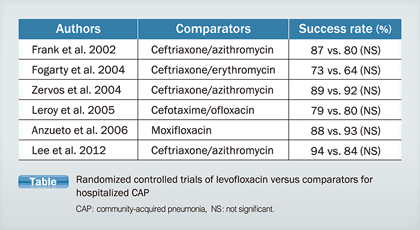Levofloxacin: a Mainstay of Fluoroquinolone-Based Therapy-After Twenty Years of Use, Levofloxacin Remains Safe and Effective
Levofloxacin: Maintaining Efficacy in the Treatment of Community-Acquired Pneumonia


CAP remains one of the most significant infectious diseases, with a huge impact on both individuals and healthcare systems. In the US alone, there are 5.6 million cases a year, with more than 1 million requiring hospitalization and over 55,000 deaths. While the mortality for ambulatory patients is less than 1%, this rises steeply to approximately 12% for those requiring hospitalization and approaches 40% for those admitted to ICU. The economic impact of this has been estimated at $12 billion annually, highlighting the need for developing and maintaining optimal antimicrobial regimens. Emeritus Prof. Mandell presented an overview of the current situation regarding the best therapeutic strategies for CAP patients.
Using recommendations based on IDSA/ATS guidelines, Prof. Mandell reported that optimal treatment depends on classifying patients into subgroups based on likely pathogens and severity of disease. For those who were previously healthy, with no antibiotics taken within the previous 3 months, the most common bacterial pathogen remains S. pneumoniae or Mycoplasma spp. These patients can be managed with either a macrolide or doxycycline.
While fluoroquinolones are very effective for these patients, Prof. Mandell recommended that they be used for managing more serious disease, such as those patients with comorbidities or those who have used an antimicrobial within the last 3 months. Such patients should be treated with fluoroquinolone monotherapy (usually levofloxacin 750 mg once daily) or, if they had received a fluoroquinolone in the past 3 months, Prof. Mandell would use a β-lactam plus a macrolide. In regions with a high rate of high-level MRSP, a fluoroquinolone or a β-lactam plus macrolide regimen should be considered.
For CAP patients requiring hospital admission, but not to ICU, Prof. Mandell recommended monotherapy with a respiratory fluoroquinolone, which has advantages in terms of providing once-daily therapy, with most US centers using levofloxacin 750 mg. Another option in these patients is a β-lactam plus a macrolide.
For CAP patients requiring ICU admission, aggressive combination therapy is recommended. If there is no risk of P. aeruginosa, a β-lactam (cefotaxime, ceftriaxone, or ampicillin-sulbactam) plus either a fluoroquinolone or azithromycin is recommended. However, if Pseudomonas is a concern, the patient requires double coverage with an antipneumococcal, antipseudomonal β-lactam such as piperacillin/tazobactam or meropenem, together with 750 mg levofloxacin. Where community-acquired methicillin-resistant S. aureus (CA-MRSA) is a possibility, linezolid or vancomycin can be added.
It is important that the optimal duration of therapy is given and this depends on the initial response, severity of disease and likely pathogen. Well-designed studies have shown that uncomplicated CAP in outpatients can be treated with 5 days of 750 mg levofloxacin. In patients with severe CAP or with serious comorbidities, treatment can be given for 8 to 10 days and 2 weeks of treatment can be given to patients with CAP caused by P. aeruginosa or S. aureus if bacteremia is documented.
Prof. Mandell reported on a meta-analysis of CAP treatment, which compared macrolides or β-lactams with oral fluoroquinolones. Results confirmed that newer fluoroquinolones were associated with a therapeutic benefit compared with alternative treatments (1). Prof. Mandell also reported on results of 6 randomized controlled trials comparing levofloxacin with combination therapy in hospitalized CAP patients (Table). He stressed that levofloxacin monotherapy was as effective as combination therapy in these moderate to severe CAP patients.
 |
| Click on image to enlarge. |
Further results from a retrospective study using a large hospitalized CAP database supported the use of levofloxacin in CAP. This study compared levofloxacin and moxifloxacin and showed that initial treatment with levofloxacin 750 mg IV was associated with a significantly shorter duration of hospital stay compared with moxifloxacin 400 mg IV. Prof. Mandell noted that the shorter duration of hospital stay associated with levofloxacin is likely to result in improved patient and economic outcomes (2).
Prof. Mandell concluded that levofloxacin possesses significant advantages in the treatment of CAP. It can be given both orally and parenterally with an easy switch between the 2 forms of administration. It is prescribed as a once-daily regimen, possesses excellent bioavailability and achieves high concentrations in the alveolar macrophages and epithelial lining fluid. Levofloxacin also provides good Pseudomonas coverage and has maintained relatively stable susceptibility levels over the past 20 years, with associated excellent clinical efficacy and safety results confirmed in a large number of trials.
References
(1) Salkind AR, et al. Ann Pharmacother 2002; 36: 1938-43.
(2) Schein J, et al. Curr Med Res Opin 2008; 24: 895-906.










